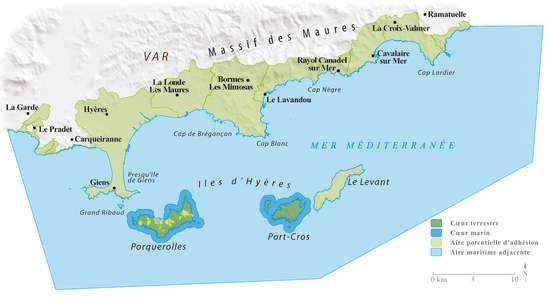In 2012, the national park was deeply reformed. After a meeting between the local professionals, the National Park area has been totally remodeled.
From now on it has:
- Two 'cores': public reception and protection areas in Port-Cros Island and the natural areas Porquerolles' Island State as well as their 600 meters marine edge.
- One 'potential accession area' used as a zone of sustainable development project established with her eleven municipalities.
- One 'adjacent marine area' from the marine accession area, covering the marine space thanks to these eleven municipalities and extended up to 3 thousand sailors in the south of the islands.
From nowadays until 2015, a close cooperation between the national park, the local authorities and all its partners will lead to a territory project inspired by the principles of the sustainable development, which will be the Chart of Port-Cros National Park. This project will be the subject of a public inquiry. The decision of the municipalities will determine the definitive accession area of Port-Cros National Park.
In cooperation with Hyères and La Croix-Valmer, the park manages the natural spaces acquired by the Coastal Conservatory of Giens' Peninsula and the Cap Lardier. Lastly, as a scientific and technical adviser, the park is also working on the management of Hyeres' Salins. The national park manages the National Mediterranean Botanical Conservatory of Porquerolles, also in charge of the protection of the wild flora and the threatened Mediterranean fruit varieties.
Since 1999, the Park is also working on a cooperation mission for the establishment and the monitoring of the International Sanctuary of the Marine Mammals, which is the result of a tripartite agreement between Italy, the Principality of Monaco and France. The latter, managed by the National Park of Port-Cros, has to lead and coordinate the actions and initiatives in favor of the marine mammals in relation to the corresponding actors (the state services, local authorities, the professionals of transportation, fishing and tourism, as well as scientists and associations). Hence, three working groups have been created for the monitoring of these actions at the French level: 'awareness', 'human activities' and 'research'.
Location : Hyères' Islands and Coastal of Var's department
Date of the park'creation : 14 december ,1963 (decree for creation modified on the 4th of May, 2012)
Park's Core 1700 ha of lands, 2900 ha of marine surfaces
Potention Accession Area (PAA) : 23 000 ha , 11 municipalities
Marine Area: 123 000 ha
Permanent Inhabitants : 350 inside the cores (Port-Cros, Porquerolles) 136 000 inside the PAA
Protected spaces : Bagaud and Gabinière's Islands, Wilderness area. PELAGOS Sanctuary, for the Mediterranean marine mammals.
: 602 terrestrial species, 500 algae species
: 144 birds species (among them, 40 nesting species), 180 fish species and some endemic terrestrial species such as the Sardinian discoglossus (small Amphibian) and the phyllodactyllus from Europe, small endangered reptile.
History : the historic heritage of this National Mediterranean park is huge and is the result of Roman remains , about thirty shipwrecks and about twenty military forts. In 2013, the park celebrated its 50th anniversary.


